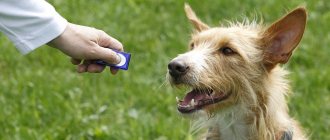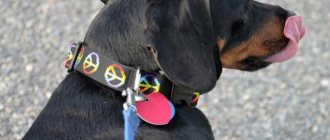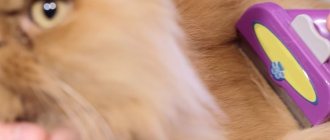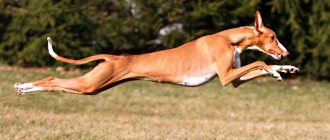Training and education are an important and integral part of life for every domestic dog. She must know the basic rules of living next to people and unquestioningly fulfill the owner’s requirements. To make this task easier, there is a special accessory.
A clicker is a smart assistant for dog training. This simple device was invented by a woman, American biologist Karen Pryor, dolphin trainer and writer. She was the first to put it into practice.
What can you do with it?
Using the clicker is very simple; even a child can cope with this task. You can start training your four-legged friend with its help at puppyhood.
When the pet has fulfilled the command, request or instruction of the owner, or is simply behaving approximately, just press the button and the dog will hear the coveted click, after which he must be given a treat.
Gradually, the dog, at the subconscious level, begins to associate the sound of the clicker with the execution of the command and understands that tasty reward will follow. Thus, a conditioned reflex is formed in the animal and the “click - executed command” pair works 99% effectively.
A clicker is a very useful thing. It is easy to use and affordable. It can be used to train any breed of dog. It will be one hundred percent useful for beginners and professionals.
Advantages and Disadvantages of Using Clickers for Dog Training
To understand how to use a clicker to train a dog, you need to know about all its advantages and disadvantages. Here are the undoubted advantages:
- The sound is always the same, so there is no need to worry - the animal knows that you deserve a reward.
- Thus, training takes place in a calm environment, without stress for the dog and the handler.
- The speed of obtaining results in higher education is a clicker.
- The clicker allows you to more accurately adjust the dog's behavior. Because the animal understands commands better, remembers them reliably, and is easy to understand.
- Even if the dog is on a walk quite far away, he hears the sound of the clicker.
- The clicker is very convenient to use, it is small, fits in the palm of your hand, you can carry it with you literally everywhere.
However, this convenient and effective tool has its drawbacks when used remotely, paused for a while or only used in certain circumstances:
- Propaganda. An overly emotional dog may become agitated when it hears a sound. Be too active to be happy that now you will receive a reward and forget about everything. In this case, you must work first to balance the animal's condition, working with it only in a calm environment and in an even mood. This will require the coach's patience and perseverance.
- Fear. Some animals are afraid of sharp sounds, even clickers. Perhaps this lies in the past. The dog once had an eerily similar sound, and is now exhibiting the same behavior. In this case, you must first rid the animal of fear with the help of special exercises, and then use the clicker.
- Impaired hearing or deafness. Unfortunately, not all animals have excellent health. Quite rare, but there are dogs that suffer from deafness for various reasons. Of course, using a clicker is useless. However, you can replace it with a signal light.
When to enter a voice command
You don't have to carry your dog clicker with you all the time. After the action is mastered, the dog will perform it without a special sound signal, upon a voice command. Use a treat or affection as a reward.
Before you can enter a voice command, you need to click to complete the action. And only after that introduce voice accompaniment. First, the animal must understand that it is being rewarded for following the “sit” command. Then the understanding comes that she will receive a reward only if she follows the voice command “sit.”
Types of clickers
Halter for dogs: what is it and what is it for?
There is a wide variety of devices on the market today. Some have a quiet signal, others a loud one, etc. There are three main types:
- button clicker. When using it, you can press the button with your hand or foot. Another feature is the emission of a quiet click;
- lamellar. The sound signal can only be played with your fingers; it has a loud click. It can be used outdoors, in places that distract the animal. There are models in which the sound level can be adjusted;
- Target clickers are mainly used by professional trainers to teach dogs complex commands. Its price is significantly higher than previous types.
What can be replaced
As a replacement, miracle devices are offered:
- fountain pens, which suggest abandoning them in everyday life in favor of mechanical ones;
- flashlights used for deaf pets;
- whistles;
- staplers;
- baby food jars that click when you squeeze the lid;
- children's toys that make clicking noises.
All alternative options considered are inferior to the device due to its inability to reproduce the original signal. A flashlight can be considered as a replacement, and only if there are individual characteristics of the pet.
The device allows you to speed up the learning process, develop initiative and does not require constant use.
It is still better to purchase an industrial device
What is a dog clicker
The clicker itself is a small box with a metal insert inside. If you press this insert, the device makes a certain click. Many people believe that the mechanism contains ultrasound or infrared light, but this opinion is incorrect. A click is a click, which can have a beneficial effect on an animal’s behavior if trained correctly.
Advantages of the device:
- Unique device sound. There are no analogues to this sound in nature, and an animal in another place will not be able to hear it. If you use words like “Yes” and “Great” during training, you can also use them in life, and the dog will perceive this as a positive signal;
- The clicking sound of a special mechanism is always a constant sound. No other click, whistle or voice can reproduce the same sound, and even several times a minute. Such a sound is remembered very well by the animal and it will not be able to confuse them with other sounds;
- Compact, lightweight device. There is no other similar device;
- Various squeaky toys and whistles cannot replace this device;
- Usually the clicker is made of high-strength plastic with a special bracelet that is convenient to attach to your hand;
- Having a clicker does not mean the dog behaves perfectly at that moment.
- The main thing is to use the device correctly and often;
- A training device will only help if there is already contact between the owner and the dog. Only in this case will training be truly effective;
A dog clicker should not be used as a substitute for praise. Praising your dog is very important and should be done during training and games, even if the animal does not follow commands correctly. In this case, it is worth spending more time on exercises.
How to use the device correctly
Like any device, you need to know how to use a clicker correctly. For good results, you need to carefully study the methodology and have a good idea of what exactly needs to be done and at what moment:
- The sound of a click (click) should be associated with something pleasant - a treat, verbal praise, affection, a walk.
- Training should begin with the simplest thing - encourage the dog to come up, extend its paw, and touch your hand.
- Use just one click.
- If you want to praise your dog more than usual, increase the portion of the treat, but not the number of clicks.
- Training should be regular.
- It is better to exercise every day for 10 minutes than one hour once a week.
- Do not punish the dog for unwanted behavior, place the main emphasis on desirable behavior.
- For example, to teach silence, we do nothing while barking, but praise for silence
A clicker for dogs will help you master a variety of actions. For example, if you like it when your dog stands on its hind legs, click the clicker. He will quickly understand that you like it.
When to enter a voice command
You don't have to carry your dog clicker with you all the time.
After the action is mastered, the dog will perform it without a special sound signal, upon a voice command. Use a treat or affection as a reward. Before you can enter a voice command, you need to click to complete the action. And only after that introduce voice accompaniment. First, the animal must understand that it is being rewarded for following the “sit” command. Then the understanding comes that she will receive a reward only if she follows the voice command “sit.”
Conclusions about using a clicker
Using a clicker to train dogs is now a popular practice. This is a simple device with a unique sound that will help you quickly learn basic commands and improve the animal’s behavior without affecting the psyche and emotional state of the animal. Proper training will allow you to learn basic commands in a few days.
Currently reading:
- 5 methods to teach your dog not to react to cats
- Games to choose for training a dog
- Seven Signs and Remedies for Getting Rid of Fleas in Dogs
- Is it worth it or not to include natural food in your dog’s diet?
Terms of use
According to reviews from experienced dog breeders, the clicking whistle has a simple mechanism of action and ease of use. However, like any other technical device, a clicker requires a certain technique of use. So, let's figure out what rules of use should be followed to achieve high results:
Training should be frequent but short-lived. It is better to do 10-minute sessions every day rather than hours of training once or twice a week. Long intervals between training do not allow the animal to quickly and correctly remember the command being studied.
Each successfully completed task should be rewarded not only with the click of a whistle, but also with the animal’s favorite treat, praise from the owner, scratching or stroking.
It is recommended to first use the clicker to memorize the simplest commands, gradually increasing the load and level of difficulty.
Using a clicker, you can not only teach your dog new rules, but also wean your dog from bad habits or previously incorrectly trained commands. It is better to conduct the first lesson in a room where there is no extraneous noise that distracts from the lesson. The dog must become familiar and accustomed to the clicker.
By adhering to the above recommendations, you will be able to teach your animal new commands and good manners in the shortest possible time.
Recommended Posts
Healthy treats for dogs or how not to harm your pet
Review of 8 super premium dog foods
How to successfully train your dog to walk on a leash
How to choose and use toothpaste for oral hygiene in dogs
How to choose and use a cat harness correctly
How to choose and use a cat collar correctly
Basic rules for training with a device
To properly train your dog, you need to know how to use a clicker correctly. There are some rules:
- Do not start learning commands if the animal does not have a conditioned reflex. First you need to establish good contact with the animal, spend more time and use additional techniques to improve behavior;
- Using a signal, you need to confirm the animal’s correct action; if the command is performed incorrectly, you need to say it out and not give the treat. This is necessary so that the animal does not develop incorrect reflexes;
- Do not use a signal to attract attention. It is better not to use a clicker to play the game or just use the signal for the sake of it. It is recommended to show your dog the device only during training;
- The dog itself must understand why it receives food. Good behavior will be reinforced with a click, and the animal will receive a treat. This is why a time frame is needed; long breaks in this practice are not advisable. It is better to achieve results and maintain them;
- If you want results, you need to increase the number of workouts and increase the amount of food. Such encouragement will only improve results, and the animal will follow commands well;
If a dog shows results, it should be rewarded twice as much. Such actions should not be frequent, but for the animal this is an additional incentive. If an animal performs incorrect actions, you should not focus on this, it is better to use the signal several times additionally. But you should take a long pause between clicks.
Using the clicker training method is not designed for command. It reinforces a certain type of behavior and helps to form the correct behavior. Unlike conventional training, the use of clicks is gentler and does not suppress the animal’s natural behavior.
Once you have achieved results, using the clicker is no longer necessary. But it won’t hurt to conduct periodic training. If the result was good only within the house, you can train outside. Create different conditions for the dog and ensure that commands are followed, regardless of the situation.
Myths about clicker training
A selection of myths and superstitions about clicker training that are often found among dog owners, creating confusion and a barrier to training and training dogs.
" Traditional methods don't work " " clicker training doesn't work "
Well of course they work. Thousands of pet, sporting and working dogs testify to the effectiveness of both methods. As long as a particular method takes into account the dog's individual learning characteristics, it will work.
«There is no method that suits all dogs.»
True, at least in the form of written text. A method is a recipe, step-by-step instructions for training a dog or correcting its behavior. No recipe is suitable for all dogs without exception, which is why so many alternative methods have been developed, and many of them differ from the previous ones only in details. In fact, the history of dog training can be traced from trainer to trainer through their techniques.
Unfortunately, techniques limit the trainer if he does not understand how they work. In the past, trainers taught only through methods, ignoring how those methods worked. Because of this, some dogs (and sometimes entire breeds) that were not suited to these techniques were mistakenly labeled as "stupid", "stubborn", "dominant", "too soft", "too excitable", "aggressive", or “easily tired” from activities.
Clicker training, although it contains step-by-step instructions, is not a method. This is a behavior change technology that focuses on the principle of learning. For the first time, the ability to tailor a technique to a dog’s individuality, change it, or even create a new one comes from such indefinable areas as “instinct,” “experience,” and “talent.” This can be taught to anyone - from novice owners to professional trainers.
Skillfully applied clicker training will work for any dog that is mentally and physically capable of learning, because no dog is immune to training.
" Traditional methods are cruel and inhumane " " Dogs trained with traditional methods are cowardly/aggressive/miserable " " Cowardly dogs must have been traditionally trained and abused "
These myths are usually propagated loudly and persistently - although they are equally unfair and untrue. Are there people who inhumanely use negative reinforcement in the name of training? Certainly. Are there traditionally trained dogs that fail the training and become fearful, aggressive, or unhappy? Unfortunately yes. However, many remain happy workers, and an unhappy dog does not appear to be a sign that it has been abused during training.
«Since all dog learning can be explained using operant conditioning theory, all dog trainers use it»
Kids can do some pretty damn interesting experiments with a young chemist's kit, but that doesn't make them chemists. My husband made a great table - but that didn't make him a carpenter. I can stick to a recipe in a cookbook or randomly throw together ingredients for a dinner dish - but that doesn't make me a cook. To be a chef, a carpenter, or a chemist requires an understanding of the subject that goes far beyond following a recipe or experiment step-by-step. The same applies to operant conditioning.
The fact that a training technique can be explained using an operant method does not mean that the trainer using this method is using operant conditioning itself. To train using the operant method, you need to understand its principles inside and out, be able to apply them in any situation and to any individual, and modify them accordingly. “Operant trainers” are not limited to clicker training (just as not every clicker trainer is an operant trainer), but since clicker training is entirely based on training principles from the earliest stages, most operant trainers use a clicker.
“ Clicker training is limited ” “ Clicker training cannot teach everything {or any specific skill}”
You can teach your dog anything with a clicker - from the command to sit to good manners and from sports to work disciplines. Everything.
“ Clicker training is ineffective because no dog trained with it has become {insert your favorite achievement or desired title here}” “ Clicker training cannot be used to train sport dogs or therapy dogs .”
Clicker training is not a new technology, but it is relatively new in the dog world. Thanks to the efforts of ordinary dog lovers, it has gradually gained popularity over the past 15-20 years. However, clicker training courses have only begun to open more or less regularly in the last few years. Before this, trainers mostly trained on their own, using mailing lists, websites, and a very limited number of books and videos. Even now, most courses are aimed at the average dog owner.
A would-be dog trainer who wants to train a dog using traditional methods has many resources at his disposal because many, many others have gone down this path before him. There are already existing proven methods, experienced athletes who can help, and many trainers who will undertake to teach. An impressive library and video library also help.
Those who want to train a sporting dog using clicker training are not so lucky. In some disciplines, such as agility and freestyle, trainers who use clickers predominate. There are already impressive educational materials accumulated there. But in other disciplines - for example, training hunting dogs - there are no materials at all to help the beginning athlete. It is not possible to transfer traditional methods to a clicker; the trainer - usually also a beginner - must start from scratch.
To get a title (in any discipline!) you need...
- A trainer who is fluent in the methodology he uses to teach.
- A coach who perfectly knows the sports discipline in which he participates and what skills are needed there.
- a dog that has the ability and is physically able to perform the required exercises with sufficient accuracy to win.
- Desire to train and compete enough to achieve a title
- Finances to train and compete enough to earn a title
- Time for training and competitions
- Training Mastery to Achieve a Title
You need to have absolutely every one of these elements. Everyone. In reality, it takes years to become advanced enough to reach the top levels of any sport, even if you already have the resources and support to do so. For instructors who strive to enter a sport in which no one has yet paved the way or invented recipes, the path becomes exponentially more difficult and difficult.
It will happen. Every year more and more borders are crumbling. All we need is time for everything to fall into place. [Editor's note: Since this article was published, clicker-trained dogs have won every award possible and continue to do so.]
The clicker is not allowed in the sporting ring or during therapy visits (by many dog registry organizations and groups). But you can certainly use it to train your dog for competition or work (remember, it all revolves around reward history and stimulus control). Fortunately, you can use a clicker during the warm-up ritual (in competitions it is customary to warm up the dog outside or away from the rings, this is part of good form if you use a clicker - so as not to distract the performing dogs).
«Clicker trainers do not use punishment.»
Wrong. Clicker trainers use negative punishment—when the dog doesn't get something he wants. For example, “penalty meters” (Lana Horton) is a common technique used when training a dog to walk on a loose leash. The dog sees something that it wants to approach. While the dog is walking without pulling on the leash, the instructor allows it to move in the direction of the goal. If the dog starts to pull, the trainer moves it in the opposite direction. We go the right way, we get what we want - positive reinforcement. We delay, we lose what we want – negative punishment. Dogs understand this technique very well because losing or getting what they want is controlled by their own behavior.
«The introduction of an aversive (positive punishment) is more severe, but also more reliable than the removal of reinforcement (negative punishment)»
Is positive punishment harsher than negative punishment? What about positive reinforcement? Is it more or less effective than negative reinforcement? Is it more or less effective?
Each use of reward and punishment, positive or negative, can be rated on a scale from mild to extreme. And what exactly the impact will be according to this scale depends on the individual dog and the specific situation.
Likewise, punishment and reinforcement are determined by outcome. So by definition they work and are effective. Influences that involve positive punishment, even if applied correctly, can still have side effects. Both require skill to apply, but the potential negative impact on training and dogs is more likely to have positive punishment applied incorrectly.
«Mechanical correction is vital so that the dog understands that he must obey»
Not true. Reliability is a number. Statistics. Boring statistics that have nothing to do with “choice” or “control” - or the method by which the result is achieved. Reliability is achieved through reinforcement of repetition. True reliability is achieved during the process of acquiring fluency in a skill, quite some time after the animal has passed the stage of doing something only due to influence, positive or negative.
I've driven manual transmission cars for over 10 years. During this time I had an incredible amount of reinforced behavior (meaning the car did what I wanted it to do) using the clutch.
I remember learning how to use this clutch. It was terrible because I don't have very good coordination. Shifting while driving was not that difficult, but getting going was a pain. So we did a lot of repetitions. We started in the parking lot - no distractions, just a few restrictions. When my skill became more or less reliable, we increased the requirements and moved to the next street. It was like I started from scratch, but after practice my skill improved. We then moved to busier streets. Oh - again a setback in skills! But I quickly caught up again. Gradually the streets became more congested and difficult. We added hills. We added pressure from the realization that there was a line behind me at the traffic light. Yes, I had thousands of repetitions before I learned to move off relatively softly. For quite a long time, using the clutch to move a car was a deliberate and conscious behavior. I had to think about my actions all the time. After some time this changed and I don't pay attention to it anymore. This is not necessary because this skill has become fluent. The delay is zero. Reliability is something around 100%.
About that. Because one day after the rain on Thursday I might stop the car. It happens. I'm not perfect, even after more than ten years of repetition.
And yet my behavior is under control. I can refuse to use the clutch whenever it occurs to me. I may deliberately release the clutch. Never, never, never will I lose control of this skill.
There is only one way to achieve truly reliable behavior. Targeted exercises. Generalization of skill. Practice in conditions that require reliable performance of the skill. Working on delays in execution. Continue to keep a training diary and train until you reach your desired level of reliability, be it nine out of ten or 999 out of 1000.
You determine which signals are more reliable and trigger immediate responses during practice. But never fool yourself into thinking that training, no matter how hard you use it, can override free will.
«The click must be followed by food reinforcement»
Not true. The click should be followed by a reward—something the dog wants to get for the job. You may have a whole range of reinforcements in your arsenal. The most common of them are the following:
- food
- toys
- praise, attention
- opportunity to do something the dog wants to do
- ability to execute a well-known command
Typically during a training session you aim to do as many reps as possible. Food is an excellent reinforcer because it can be cut into small pieces and the dog eats them quickly. Toys are also a good option, but games take time, which means there will be fewer repetitions during training. Praise and attention are great additions to toys and food, but are usually not coveted enough for a dog to want to work for them alone, especially in a high-stimulus situation. The opportunity to do something different is often the most powerful reinforcement you have at your disposal.
The most important thing to remember is that the dog determines what is or is not a reinforcement for it in each specific situation. If the dog does not want what you offer it, then this is not reinforcement.
“ Clicker training does not always work because food is not a strong enough reinforcer ” “ Instinctive desires and self-reinforcement are so strong that mechanical correction must be used to achieve reliability ”
As mentioned in the last paragraph, food is not the only reinforcer available. Regardless of which reinforcer you choose, keep in mind its relative value. Different foods may be more or less desirable. The string you use to play tug-of-war can be more valuable than food in certain situations. Being able to say hello to another dog may be the best thing ever! It all depends on your dog and your specific situation.
One of the most common fears is that there are things that the dog really wants, but cannot get. Or that the dog exhibits a very strong, instinctive desire for which the trainer cannot find a reinforcement that would be more valuable. So listen: you don’t have to! This is where clicker training has come a long way! She left the operant method far behind and applied techniques based on classical training - desensitization and attention switching. Desensitization reduces the strength of an animal's response to a specific stimulus. Switching can be used to shift the focus of desire from an undesirable object to a desirable one, even if they are not related to each other.
Just imagine: a border collie sitting at rest next to a football field with squealing children running around; an athletic dog that maintains concentration in the vicinity of running people, squirrels, birds, people playing ball, and jumping dogs; energetic Malinois, interrupting the attack on a single command, although you really want to bite the defendant. This is what powerful desensitization and switching are.
«Full class of clicking people confuse the dog»
We do not live in a vacuum, and dog training does not take place in a vacuum either. Dogs pay attention to the big picture of the world around them: body language, verbalization, emotions, clicker, treats, and so on. Your dog knows very well which click refers to him.
“ Dogs that are clicker trained and will only work in the presence of a clicker or food ” “ You will have to use food and clicker forever ” “ You should always carry your clicker and food with you wherever you go ”
People are terrified at the prospect of being tied to a clicker and treats. Fortunately, they have nothing to fear.
A clicker is an event marker used to mark correct performance during the early stages of learning a new skill. Once the skill is fully developed, commanded, and stable enough, you no longer need as much precision in your clicker use. Therefore, you can simply replace it with a verbal marker or command. If you don't have a clicker with you, you can always give a verbal marker - or simply reward your dog without saying anything.
Food, as mentioned earlier, is not the only type of reward available. Yes, you need to continue to reinforce the desired behavior, at least occasionally, but it doesn't have to be a treat or anything you "give" to your dog. Instead, you can let your dog do something he really enjoys, or if you're lucky, the behavior will become self-reinforcing!
Of course, treats can be used incorrectly. Some people complain that their dog only does things if he knows there is food. This is a great example of dogs' insight. If food is visible every time during training - no matter whether you lure the dog with food or have it in your purse around your waist - the dog will quickly understand that food is part of the training. And this problem concerns not only food rewards. Usually dogs are trained to follow commands only when they are in front of the trainer, while the trainer is standing, and all this on a specific site. These problems can be avoided if you vary all conditions that do not directly affect the dog's behavior.
“ Clicker training is just the ability to press a button ” “ Clicker training is too difficult for beginners ”
Unfortunately and fortunately, none of these statements are true. The technique of using a clicker is simple, but it is not easy. Even if you have great step-by-step instructions, proper training requires some skill. Fortunately, dogs are amazing at forgiving us of our mistakes, and they work very hard to understand what we want from them. Although “timing” is often presented as the holy of holies of clicker training, the reality is that even a person with absolutely terrible timing can teach a dog absolutely any everyday skill (as well as the vast majority of sports skills).
Other people are overwhelmed by the theory of clicker training. They just want to follow instructions and train their dog. And this is understandable and in the order of things! Many people find step-by-step instructions and train their dogs with them without really understanding or delving into exactly how the instructions work. They don't use the operant method, but they still get great results.
«Clicker training is like juggling.»
It seems like you need to have three hands (or more!) to do clicker training. Learn the mechanics of using a clicker in the same way you learn “sit” and “down” with a dog. Grab a leash, clicker, and a treat (candy or something you crave) and practice without your dog (these treats are for you!). Another way to practice is to ask a friend to tap the ball on the floor, your task is to click/yum every time the ball hits the floor.
«The clicker is a magical item necessary for training.»
I'm amazed at the number of people who point a clicker at their dog, make a clicking sound, and then when nothing happens complain that clicker training doesn't work. A clicker is not a remote control!
A clicker is a small thing that makes noise. The first clicks are completely neutral. However, when an association with food or other reward is built, it takes on the properties of that reward. But its strength is not that the sound encourages, but that it is a marker of the event. And as an event marker, it (in the right hands) works like a scalpel that can be used to carve out surprisingly precise behavior. A verbal marker, by comparison, is a butter knife. What do you need? If a butter knife fits, there's no doubt you can train without a clicker. But if you need a scalpel, then a clicker - or other similar, species-specific marker - is the best way to achieve skill accuracy without the risk of creating negative associations with training.
“ A clicker is a bribe ” “ The dog will listen to me only if I have a clicker/treat ”
Not true. The dog will not do what you ask until you have reinforced the skill and command. Once the dog has memorized the command and learned the associated behavior, this is no longer a problem. Using the correct clicker training technique is also an important point in preventing your dog from bribing – keep your hands off the bag of treats!
“ The clicker works like a team ” “ Clicker trainers walk around with a bunch of behaviors not assigned by the command ” “ Clicker-trained dogs constantly offer different behaviors ”
A command names and causes a specific behavior. The clicker labels the behavior as it occurs. Clicker trainers do not call a skill a command until the dog offers exactly what is needed for two reasons:
- When a puppy is taught a skill, we want him to focus only on that skill. At the moment, the command is meaningless to him, it's just additional noise that needs to be filtered out. At the beginning of training, in order to make it easier, the number of stimuli (including the name of the team that is still meaningless to him) should be reduced to a minimum.
- It makes sense to associate the command with the ultimate, perfect execution of the skill. If you lead your team early, you run the risk of getting an unfinished skill when you least expect it. For example, when a dog is stressed in a competition, even if you have trained it to follow a command more accurately.
First, bring the skill to the required execution. Then, when the dog is already actively suggesting the desired execution, add a command. For something simple, this can happen on the first day!
More complex skills take longer to develop. If the skill is VERY complex, for example, it is a chain of actions, you can add commands for individual elements, and then add a command for the fully formed chain. Or, if this is a single action, but quite complex, you can use temporary commands for training, and then, when the skill is fully formed, replace them with one permanent one.
«The clicker does not work with excitable or aggressive dogs.»
Using a clicker when working with an excitable or aggressive dog helps calm the dog down. Once the dog understands that clicking means reward, he begins to feel calmer and more confident. They like to know that a click always means the same thing - in the training area, at home, on the street, alone or with other dogs, anywhere. The clicker increases self-confidence and a sense of comfort in excitable dogs because it reinforces the behavior that the dog should show in a critical situation and creates positive associations with this situation.
«Sound-sensitive dogs hate clicker training»
There are different types of clickers with different click volumes. Experiment! If you can’t find a clicker that’s comfortable for your dog, you should try using a ballpoint pen, a canned food lid, children’s toys – use your imagination. You can also put the clicker in your pocket or move your hand with it behind your back to slightly reduce the volume of the sound. Always be careful not to click close to the dog, especially his ears.
«Clicker training is permissive»
Clicker training doesn't mean you deny your dog anything. Behavior that is reinforced by clicking/food remains, ignored behavior goes away. Ignoring actions and/or not clicking tells the dog “no, that’s not what I want.”
«You should not praise your dog during clicker training.»
Oh, of course you can! After the click, praise as you like. I encourage trainers to remain silent until the click so that the dog can calmly think about how to earn the desired click. However, after the dog has finally earned it, you can safely celebrate and praise. Let exercise improve you and your relationship - love your dog!
Sources: “Clicker Trainers Use No Punishment” and Other Training Myths and 10 Prejudices Owners Have Against Clicker Training That Are Wrong
See also:
- Old dogs and new research
- How to evaluate a dog's intelligence?
- How did a T. rex make your dog colorblind?
- To cut or not to cut: what do we know about the properties of fur and thermoregulation in dogs
- The sad truth about dogs and depression
- Key Canine Genetic Innovation: Diet
- Quality of life for dogs
- When the nose doesn't know: how health, living conditions, training and microbiota affect a dog's sense of smell
- Is your dog kind?
- Can dogs make and use tools?
- 53
Shared - 44
- 1
- 8











